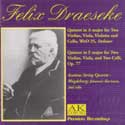All Felix Draeseke Program:
- Clarinet Sonata in B flat op 38
- Viola Sonata No. 2 in F, WoO 26
- Quintet
in
F
for
Strings,
op.
77 (newly made arrangement for string quartet and double bass by Anthony Scelba)
-
Brennan Sweet, violin
-
Victoria Stewart, violin
-
Brett Deubner, viola
-
Na-Young Baek, cello
-
Anthony Scelba, double bass
-
Alexander Fiterstein, clarinet
-
Gabriela Martinez, piano
Earlier this year, Dr. Anthony Scelba (pronounced shelba), virtuoso double bass player and chair of the music department at Kean (pronounced cane) University in Union, New Jersey joined the International Draeseke Society/North America. As a double bass player he had been attracted to Felix Draeseke's String Quintet in F major (two celli), Op. 77 and had made an arrangement of the work featuring his instrument, something he had also done with Schubert's string quintet in C major. Taking advantage of the Society price for AK/Coburg recordings, he ordered all of them.
After a bit of time Dr. Scelba contacted this writer and expressed his unequivocal belief in the importance of Felix Draeseke and his unique style, so much so that he was planning an all-Draeseke chamber music evening in the fall concert series at Kean University. Most Draeseke enthusiasts begin with discovery of Draeseke's Symphonia Tragica via available recordings, but with Dr. Scelba, the professional artist, his admiration has had initial beginnings in Draeseke's chamber music and his enthusiasm has engendered parallel response in those with whom he associates. It is a daring but risky proposal for any concert organization to execute an entire evening devoted to unknown works, especially at an American academic institution. What heartening revelation that the administration of Kean University - not with mere tolerant indulgence of such undertaking but actual encouragement - gives unequivocal support to faculty and student cultural initiative. A number of deans attended the concert and I was indeed introduced to them, all of whom expressed honest and deeply felt satisfaction with all that was taking place.
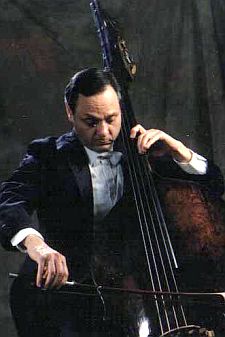 Presented in Kean Hall on the university campus, the concert started at 8:00 PM, with a half hour (7:15-7:45) discussion between Dr. Scelba and me bringing information about the International Draeseke Society and the composer it represents to the audience in attendance. I think it not too vain to judge that the reasonably large audience enjoyed some of the often ironic locutions and sometimes uninhibited delivery employed by this speaker. Needless to say, Dr. Scelba directed commentary to the works on the program: Draeseke's Clarinet Sonata in B flat major, Op. 38, the Sonata No. 2 in F major for Viola and Piano, WoO 26 and the String Quintet in F major, Op.77 which gave him opportunity to elucidate on his arrangement of the work with double bass. At the conclusion of the discussion, there was a fifteen minute pause for the final seating for the concert. The concert was not free and when the doors were shut, every seat had been taken: a total sellout. After intermission my cursory perception was that all had returned, and the audience was made up of a wonderful cross section of age, from the expected youth of the students, through to the genuine elderly. Since Kean University's audio-visual people video taped the entire evening, after editing readers of this article will have a chance to justify for themselves whether the comments here are indeed accurate for the concert is being made available to various outlets for broadcast. Presented in Kean Hall on the university campus, the concert started at 8:00 PM, with a half hour (7:15-7:45) discussion between Dr. Scelba and me bringing information about the International Draeseke Society and the composer it represents to the audience in attendance. I think it not too vain to judge that the reasonably large audience enjoyed some of the often ironic locutions and sometimes uninhibited delivery employed by this speaker. Needless to say, Dr. Scelba directed commentary to the works on the program: Draeseke's Clarinet Sonata in B flat major, Op. 38, the Sonata No. 2 in F major for Viola and Piano, WoO 26 and the String Quintet in F major, Op.77 which gave him opportunity to elucidate on his arrangement of the work with double bass. At the conclusion of the discussion, there was a fifteen minute pause for the final seating for the concert. The concert was not free and when the doors were shut, every seat had been taken: a total sellout. After intermission my cursory perception was that all had returned, and the audience was made up of a wonderful cross section of age, from the expected youth of the students, through to the genuine elderly. Since Kean University's audio-visual people video taped the entire evening, after editing readers of this article will have a chance to justify for themselves whether the comments here are indeed accurate for the concert is being made available to various outlets for broadcast.
The clarinetist featured in Draeseke's Clarinet Sonata in B flat major, Op. 38 was Alexander Fiterstein and his partner, the Venezuelan born pianist Gabriela Martinez who also performed with violist Brett Deubner in Draeseke’s 2nd Viola Sonata on the program. Fiterstein, born in Russia, raised in Israel and now 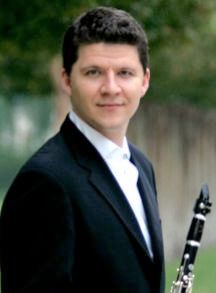 domiciled in the United States is a young professional of already international stature. What luck for the Draeseke concert that Kean University had him on its roster for, quite frankly, having heard this sonata a number of times in Europe, this listener was absolutely stunned by Fiterstein's interpretative artistry: impeccable technique, sensitivity to timbre change, dazzling virtuosity but above all an amazing instinct for Draeseke's style, a style that is not always fully realized by performers playing Draeseke for the first time - all this to say that for me the Fiterstein/Martinez collaboration was the finest performance of Draeseke's Clarinet Sonata which he has ever heard, live or otherwise. Draeseke's duo works are exactly that and both performers have to be perfectly in sync, not only on the same level with performance technique, but with equal understanding of the composer's idiosyncrasies and how to integrate and project them. This listener was mesmerized throughout by the intimate collaboration of Fiterstein and Martinez. One gasps when realizing that the extremely lovely Gabriela Martinez has been a child prodigy and at the age of 23 plays piano like a veteran of decades. With reams of critical acclaim for both performers attesting their abilities, what struck me most in the performance of Draeseke's Clarinet Sonata - perhaps his most frequently played instrumental work - were the beautiful collaborative gestures which kept the flow of music such irresistible encounter. Each movement seemed projected, as the composer would have wished, with wonderful rhythmic elasticity and spellbinding contrivance demonstrating that Draeseke's harmonic counterpoint is not wayward mannerism but marvelously woven strands of melodic invention revealing masterful tapestry of form and content. Fiterstein's opening in the first movement was disarmingly simple but suddenly the listener was aware of disciplined, exciting virtuosity. The beautifully calculated registrations in the slow movement reveal what sensitivity Draeseke has for the nature of the featured instrument and the clarinetist provided marvelous juxtaposition and transition in register timbre. Fiterstein and Martinez seemed to revel in the (too many) quirky humor of the scherzo and it was in this movement especially that one could see the enjoyment of interplay between clarinetist and pianist. The finale was breathtaking, perfect in every respect and Fiterstein did not hold back on the virtuosity demanded by Draeseke. Martinez was a veritable orchestra in her accompaniment. The audience erupted in overwhelming applause for the performers and appreciation of the work. For most present, it was likely the first Draeseke they had ever heard. With performers like Fiterstein and Martinez the master had been well served. A commercial recording of this clarinet sonata with the two of them simply has to be made. Anyone reading this who has inroads with CD producers (Naxos? Arte Nova?), please plead for a disc (and Fiterstein has a whole ready repertoire from which to choose disc mates). domiciled in the United States is a young professional of already international stature. What luck for the Draeseke concert that Kean University had him on its roster for, quite frankly, having heard this sonata a number of times in Europe, this listener was absolutely stunned by Fiterstein's interpretative artistry: impeccable technique, sensitivity to timbre change, dazzling virtuosity but above all an amazing instinct for Draeseke's style, a style that is not always fully realized by performers playing Draeseke for the first time - all this to say that for me the Fiterstein/Martinez collaboration was the finest performance of Draeseke's Clarinet Sonata which he has ever heard, live or otherwise. Draeseke's duo works are exactly that and both performers have to be perfectly in sync, not only on the same level with performance technique, but with equal understanding of the composer's idiosyncrasies and how to integrate and project them. This listener was mesmerized throughout by the intimate collaboration of Fiterstein and Martinez. One gasps when realizing that the extremely lovely Gabriela Martinez has been a child prodigy and at the age of 23 plays piano like a veteran of decades. With reams of critical acclaim for both performers attesting their abilities, what struck me most in the performance of Draeseke's Clarinet Sonata - perhaps his most frequently played instrumental work - were the beautiful collaborative gestures which kept the flow of music such irresistible encounter. Each movement seemed projected, as the composer would have wished, with wonderful rhythmic elasticity and spellbinding contrivance demonstrating that Draeseke's harmonic counterpoint is not wayward mannerism but marvelously woven strands of melodic invention revealing masterful tapestry of form and content. Fiterstein's opening in the first movement was disarmingly simple but suddenly the listener was aware of disciplined, exciting virtuosity. The beautifully calculated registrations in the slow movement reveal what sensitivity Draeseke has for the nature of the featured instrument and the clarinetist provided marvelous juxtaposition and transition in register timbre. Fiterstein and Martinez seemed to revel in the (too many) quirky humor of the scherzo and it was in this movement especially that one could see the enjoyment of interplay between clarinetist and pianist. The finale was breathtaking, perfect in every respect and Fiterstein did not hold back on the virtuosity demanded by Draeseke. Martinez was a veritable orchestra in her accompaniment. The audience erupted in overwhelming applause for the performers and appreciation of the work. For most present, it was likely the first Draeseke they had ever heard. With performers like Fiterstein and Martinez the master had been well served. A commercial recording of this clarinet sonata with the two of them simply has to be made. Anyone reading this who has inroads with CD producers (Naxos? Arte Nova?), please plead for a disc (and Fiterstein has a whole ready repertoire from which to choose disc mates).
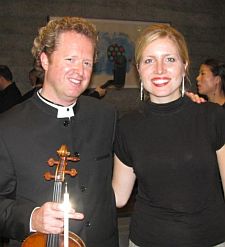 Brett Deubner, the violist featured in Draeseke's Sonata No. 2 in F major for Viola and Piano, WoO 26, is also a member of the Kean music department faculty and joined the larger quintet ensemble after intermission for Draeseke's Quintet in F major, Op. 77 in the premiere of Anthony Scelba's version with double bass. Deubner has already earned international critical acclaim as one of the outstanding violists of his generation and has quite a number of CDs to his credit (listed for perusal at his website http://brettdeubner.com). He has appeared with major orchestras throughout the world as well as in solo recitals. He confessed to me his almost instantaneous love for the Draeseke sonata, which he presented and plans to play it throughout South America on an upcoming tour. Brett Deubner, the violist featured in Draeseke's Sonata No. 2 in F major for Viola and Piano, WoO 26, is also a member of the Kean music department faculty and joined the larger quintet ensemble after intermission for Draeseke's Quintet in F major, Op. 77 in the premiere of Anthony Scelba's version with double bass. Deubner has already earned international critical acclaim as one of the outstanding violists of his generation and has quite a number of CDs to his credit (listed for perusal at his website http://brettdeubner.com). He has appeared with major orchestras throughout the world as well as in solo recitals. He confessed to me his almost instantaneous love for the Draeseke sonata, which he presented and plans to play it throughout South America on an upcoming tour.
Draeseke's F major viola sonata proved a perfect foil to the clarinet sonata, demonstrating the variety of expressive outlook in Draeseke's compositions. Preceded by the earlier, perhaps more brilliant clarinet work, the second viola sonata has a seductively lyrical quality perfectly suited to the character of the instrument. Less overtly virtuoso than the Clarinet Sonata (or its predecessor the Viola Sonata No. 1 in C minor, WoO 21), it demands a different kind of virtuosity and one which relies on an understanding partner for effective realization - in that Gabriela Martinez proved once again to be ideal. As many may know, Draeseke himself confessed that he would never have written a viola sonata for the viola prototypes generally in use at the time; it was only on encountering the new Ritterbratsche of Hermann Ritter, which its designer dubbed the viola alta, and which Wagner famously endorsed as the preferred viola for his Bayreuth orchestra, that Draeseke succumbed to its tonal qualities and enthusiastically embarked on his compositions for the instrument. Indeed the second of the sonatas was written for and dedicated to Ritter but for some reason, while acknowledging Draeseke's effort, Ritter never played it. Brett Deubner uses a 1742 viola made in Naples by Gennaro Galliano, a magnificent instrument which splendidly conveyed Draeseke's intentions and though purists might pout at this substitute for a viola alta, the realization of the sonata by Deubner and Martinez was little less than sublime.
The opening movement of the Second Viola Sonata is achingly lyrical, but also filled with moments of passionate outburst which bring drama throughout. The episodes were delivered with loving embrace by the performers and the melancholy ending was a memorable union of sobriety and resignation. The second movement is labeled Langsam und gewichtig - slow and weighty - but it contains moments of incredible turmoil - a fascinating outlay of contrast. This listener watched the keen attention to one another in the interaction between the two players; it was genuine collaborative understanding and brought out the majesty which is the second movement. The finale, indicated as mässig bewegt, leicht (with reasonable movement, light), begins in a jocular manner with an attractive typically rondo-like theme and the ear is engaged by the malleable material. It doesn't take long before the performers are suddenly confronted with a host of treacherous and subtle developmental tactics as the episodes enter and develop. The agogic problems are numerous and it was no surprise to me that, coming to the hall as preparations were being made for video recording the pre-concert talk, Deubner and Martinez were in the midst of going over certain passages in the finale. Control is truly challenged, and nowhere more so than in the fugato toward the end of the movement. The concern of the players for one another in articulation of their interpretive instincts was heartening, for a number of little instances required instant reflex, consideration and adjustment, and it brought back memories of reactions of Franco Sciannameo (who ultimately recorded both viola alta sonatas of Draeseke for AK/Coburg) who proclaimed at one point in concert rehearsals with William James Lawson his pianist (and true editor of the sonata as published) that the movement wasn't written for the viola but against it! When the video of the Kean concert is ready and broadcast, readers of this review will be able to see and hear how Brett Deubner and Gabriela Martinez dispense with this movement so brilliantly. The appearance of the glorious lyrical counter melody is melting in their hands and the denouement a study in catharsis: the gentle ending justified the sense of the inevitable and unalterable.
Despite the lack of a bravura conclusion the audience arose with tremendous applause and cheers. After the concert Brett Deubner confessed a certain trepidation during the performance since the placement of lights and microphones was other than that during pre-concert practice and it caused some anxious moments for eye contact with Martinez. Evidently blowing an instrument in front of you is less constraining than bowing an instrument under your chin. Be that as it may, the performance was an utter triumph and Felix Draeseke was once again vindicated as a major voice of late Romanticism. Hopefully, Deubner and Martinez will make a commercial CD of this (and the first viola sonata!), not necessarily to replace the existing Sciannameo/Eric Moe performances but simply to offer what all great music deserves: manifold interpretive documentation.
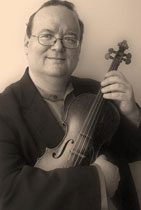 The intermission was reasonable and refreshing. When the doors closed, my visual impression was that no one failed to return for the second half. Brennan Sweet, 1st violin, Victoria Stewart (aka Mrs. Scelba), 2nd violin, Brett Deubner, viola, Na-Young Baek, cello and Anthony Scelba, double bass assembled on stage for the concluding work of the concert, the world premiere of Felix Draeseke's Quintet for Strings in F major, Op. 77 in its version by Anthony Scelba featuring double bass instead of second cello. Dr. Scelba, himself an established virtuoso who has also prepared a version of Schubert's C major string quintet with double bass (available on a promotional CD from Dr. Scelba; score and parts are published by Ludwin Music), went to great effort to explain to me that his projection of the double bass part for Draeseke's quintet was not a mere transcription of one of the cello parts for his instrument but a carefully calculated arrangement of bass line drawing on specific instances from both cello parts. This admittedly may cause some problems when the double bass part is printed, for some players may simply assume that it is a transcription of a single cello part, when it is in truth an arrangement in consideration of ensemble. Nothing has been eliminated, simply exchanged or reinforced for a sense of homogeneity. The intermission was reasonable and refreshing. When the doors closed, my visual impression was that no one failed to return for the second half. Brennan Sweet, 1st violin, Victoria Stewart (aka Mrs. Scelba), 2nd violin, Brett Deubner, viola, Na-Young Baek, cello and Anthony Scelba, double bass assembled on stage for the concluding work of the concert, the world premiere of Felix Draeseke's Quintet for Strings in F major, Op. 77 in its version by Anthony Scelba featuring double bass instead of second cello. Dr. Scelba, himself an established virtuoso who has also prepared a version of Schubert's C major string quintet with double bass (available on a promotional CD from Dr. Scelba; score and parts are published by Ludwin Music), went to great effort to explain to me that his projection of the double bass part for Draeseke's quintet was not a mere transcription of one of the cello parts for his instrument but a carefully calculated arrangement of bass line drawing on specific instances from both cello parts. This admittedly may cause some problems when the double bass part is printed, for some players may simply assume that it is a transcription of a single cello part, when it is in truth an arrangement in consideration of ensemble. Nothing has been eliminated, simply exchanged or reinforced for a sense of homogeneity.
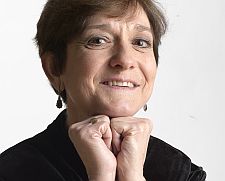 My own first encounter with Draeseke's F major quintet was a live performance with the Magdeburg group ultimately engaged to record the work for AK/Coburg CDs (DR 0004). The performance was a revelation and, as stated before the Kean audience, I reacted to the work in the state of disbelief that I recalled from my first hearing (live) of Beethoven's 15th quartet. If I deem it perhaps the greatest of all Draeseke's chamber music works, I feel justified by the fact that Dr. Anthony Scelba - the first encounter with Draeseke and from print not recording - instinctively recognized the stature of the work and the individuality manifest in it. There is no need to dote on the profound satisfaction felt in this writer, that a musician of such erudition as Dr. Scelba has committed himself to the cause of Felix Draeseke and that he has sensitive colleagues and responsive students to aid in the promotion of Draeseke's works, as well as a university administration which encourages such effort. My own first encounter with Draeseke's F major quintet was a live performance with the Magdeburg group ultimately engaged to record the work for AK/Coburg CDs (DR 0004). The performance was a revelation and, as stated before the Kean audience, I reacted to the work in the state of disbelief that I recalled from my first hearing (live) of Beethoven's 15th quartet. If I deem it perhaps the greatest of all Draeseke's chamber music works, I feel justified by the fact that Dr. Anthony Scelba - the first encounter with Draeseke and from print not recording - instinctively recognized the stature of the work and the individuality manifest in it. There is no need to dote on the profound satisfaction felt in this writer, that a musician of such erudition as Dr. Scelba has committed himself to the cause of Felix Draeseke and that he has sensitive colleagues and responsive students to aid in the promotion of Draeseke's works, as well as a university administration which encourages such effort.
The first movement of the quintet began with the requisite poise that its seemingly amorphous material demands and then gradually Draeseke's genial development unfolds. The counterpoint commands attention and the idiosyncratic voice leading seems at first elusive in meaning, the harmonies seem not to go where initially anticipated. Soon however, the attentive listener begins to grasp the strangely attractive novelty and the unsettling realization of a new voice. Scelba's ensemble had worked very hard in the preparation of the movement and beautifully realized the composer's intentions. The double bass added occasional depth particularly in moments of cadence but otherwise it was a perfect partner in the ensemble. The second movement scherzo is one 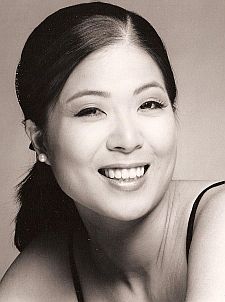 of the major delights in Draeseke's chamber music and the video tape will no doubt reveal the grins and smiley grimaces expressed at the humor by the players: enjoyment is written all over their faces, an enjoyment infectiously transmitted to the audience - one sensed the urge of spontaneous applause at the conclusion of the movement, but propriety prevailed. The third movement, Langsam und getragen (slow and measured), is perhaps the movement that awakened in me that atmosphere of late Beethoven on first hearing the quintet. Profundity conjures length, but Draeseke's movement is reasonably normal in its duration and, as with Beethoven, its depth is perceived as emotional elevation. In this movement I was aware of a fullness of ensemble nicely amplified by double bass textures, fully integrated in the overall effect, but Brad Deubner’s articulation of that strange tremolo in the measure before last was unexpectedly telling. In all of the evening's works the cyclical ideal is apparent and nowhere more so than in the finale of the F major quintet. Its groping beginning recalls the opening movement and throughout, especially towards the end, materials from preceding movements appear. Here again the contrapuntal interplay requires true understanding of Draeseke intricacies for making maximum effect and the Kean ensemble did not fail in its execution of them. The conclusion of the work again brought enthusiastic approbation and standing ovation for a group obviously evincing physical strain from its magnificent achievement, an achievement harboring vindication of Anthony Scelba's insights and trust in the worthiness of the quintet's edition with double bass. Whether this version continues with further endorsement is a matter of future decision, but double bass players have certainly been given a major work of chamber music repertoire in which to demonstrate their performance sensitivities. The presiding council of the International Draeseke Society gives unequivocal endorsement of Anthony Scelba's edition of Felix Draeseke's String Quintet in F major, Op. 77 with double bass: at present all inquiries about the double bass part should be directed to Dr. Scelba at the office of the Kean University music department. of the major delights in Draeseke's chamber music and the video tape will no doubt reveal the grins and smiley grimaces expressed at the humor by the players: enjoyment is written all over their faces, an enjoyment infectiously transmitted to the audience - one sensed the urge of spontaneous applause at the conclusion of the movement, but propriety prevailed. The third movement, Langsam und getragen (slow and measured), is perhaps the movement that awakened in me that atmosphere of late Beethoven on first hearing the quintet. Profundity conjures length, but Draeseke's movement is reasonably normal in its duration and, as with Beethoven, its depth is perceived as emotional elevation. In this movement I was aware of a fullness of ensemble nicely amplified by double bass textures, fully integrated in the overall effect, but Brad Deubner’s articulation of that strange tremolo in the measure before last was unexpectedly telling. In all of the evening's works the cyclical ideal is apparent and nowhere more so than in the finale of the F major quintet. Its groping beginning recalls the opening movement and throughout, especially towards the end, materials from preceding movements appear. Here again the contrapuntal interplay requires true understanding of Draeseke intricacies for making maximum effect and the Kean ensemble did not fail in its execution of them. The conclusion of the work again brought enthusiastic approbation and standing ovation for a group obviously evincing physical strain from its magnificent achievement, an achievement harboring vindication of Anthony Scelba's insights and trust in the worthiness of the quintet's edition with double bass. Whether this version continues with further endorsement is a matter of future decision, but double bass players have certainly been given a major work of chamber music repertoire in which to demonstrate their performance sensitivities. The presiding council of the International Draeseke Society gives unequivocal endorsement of Anthony Scelba's edition of Felix Draeseke's String Quintet in F major, Op. 77 with double bass: at present all inquiries about the double bass part should be directed to Dr. Scelba at the office of the Kean University music department.
In conclusion, I can only repeat my statement of complete satisfaction with, and sincerest thanks for, the first all-Felix Draeseke concert in the United States and Kean University's support and encouragement of its wonderful music department with its enlightened chairperson Dr. Anthony Scelba: may this event find echo elsewhere in academe and the general world of concert music.
Alan H. Krueck
Representative International Draeseke Society/North America
Download a copy of the Program Booklet 
More about this concert
 Diese Seite ist auch in Deutsch verfügbar Diese Seite ist auch in Deutsch verfügbar |
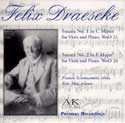 AKCoburg DR0001
AKCoburg DR0001 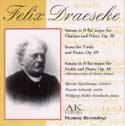 AKCoburg DR0003
AKCoburg DR0003  Presented in Kean Hall on the university campus, the concert started at 8:00 PM, with a half hour (7:15-7:45) discussion between Dr. Scelba and me bringing information about the International Draeseke Society and the composer it represents to the audience in attendance. I think it not too vain to judge that the reasonably large audience enjoyed some of the often ironic locutions and sometimes uninhibited delivery employed by this speaker. Needless to say, Dr. Scelba directed commentary to the works on the program: Draeseke's Clarinet Sonata in B flat major, Op. 38, the Sonata No. 2 in F major for Viola and Piano, WoO 26 and the String Quintet in F major, Op.77 which gave him opportunity to elucidate on his arrangement of the work with double bass. At the conclusion of the discussion, there was a fifteen minute pause for the final seating for the concert. The concert was not free and when the doors were shut, every seat had been taken: a total sellout. After intermission my cursory perception was that all had returned, and the audience was made up of a wonderful cross section of age, from the expected youth of the students, through to the genuine elderly. Since Kean University's audio-visual people video taped the entire evening, after editing readers of this article will have a chance to justify for themselves whether the comments here are indeed accurate for the concert is being made available to various outlets for broadcast.
Presented in Kean Hall on the university campus, the concert started at 8:00 PM, with a half hour (7:15-7:45) discussion between Dr. Scelba and me bringing information about the International Draeseke Society and the composer it represents to the audience in attendance. I think it not too vain to judge that the reasonably large audience enjoyed some of the often ironic locutions and sometimes uninhibited delivery employed by this speaker. Needless to say, Dr. Scelba directed commentary to the works on the program: Draeseke's Clarinet Sonata in B flat major, Op. 38, the Sonata No. 2 in F major for Viola and Piano, WoO 26 and the String Quintet in F major, Op.77 which gave him opportunity to elucidate on his arrangement of the work with double bass. At the conclusion of the discussion, there was a fifteen minute pause for the final seating for the concert. The concert was not free and when the doors were shut, every seat had been taken: a total sellout. After intermission my cursory perception was that all had returned, and the audience was made up of a wonderful cross section of age, from the expected youth of the students, through to the genuine elderly. Since Kean University's audio-visual people video taped the entire evening, after editing readers of this article will have a chance to justify for themselves whether the comments here are indeed accurate for the concert is being made available to various outlets for broadcast.  domiciled in the United States is a young professional of already international stature. What luck for the Draeseke concert that Kean University had him on its roster for, quite frankly, having heard this sonata a number of times in Europe, this listener was absolutely stunned by Fiterstein's interpretative artistry: impeccable technique, sensitivity to timbre change, dazzling virtuosity but above all an amazing instinct for Draeseke's style, a style that is not always fully realized by performers playing Draeseke for the first time - all this to say that for me the Fiterstein/Martinez collaboration was the finest performance of Draeseke's Clarinet Sonata which he has ever heard, live or otherwise. Draeseke's duo works are exactly that and both performers have to be perfectly in sync, not only on the same level with performance technique, but with equal understanding of the composer's idiosyncrasies and how to integrate and project them. This listener was mesmerized throughout by the intimate collaboration of Fiterstein and Martinez. One gasps when realizing that the extremely lovely Gabriela Martinez has been a child prodigy and at the age of 23 plays piano like a veteran of decades. With reams of critical acclaim for both performers attesting their abilities, what struck me most in the performance of Draeseke's Clarinet Sonata - perhaps his most frequently played instrumental work - were the beautiful collaborative gestures which kept the flow of music such irresistible encounter. Each movement seemed projected, as the composer would have wished, with wonderful rhythmic elasticity and spellbinding contrivance demonstrating that Draeseke's harmonic counterpoint is not wayward mannerism but marvelously woven strands of melodic invention revealing masterful tapestry of form and content. Fiterstein's opening in the first movement was disarmingly simple but suddenly the listener was aware of disciplined, exciting virtuosity. The beautifully calculated registrations in the slow movement reveal what sensitivity Draeseke has for the nature of the featured instrument and the clarinetist provided marvelous juxtaposition and transition in register timbre. Fiterstein and Martinez seemed to revel in the (too many) quirky humor of the scherzo and it was in this movement especially that one could see the enjoyment of interplay between clarinetist and pianist. The finale was breathtaking, perfect in every respect and Fiterstein did not hold back on the virtuosity demanded by Draeseke. Martinez was a veritable orchestra in her accompaniment. The audience erupted in overwhelming applause for the performers and appreciation of the work. For most present, it was likely the first Draeseke they had ever heard. With performers like Fiterstein and Martinez the master had been well served. A commercial recording of this clarinet sonata with the two of them simply has to be made. Anyone reading this who has inroads with CD producers (Naxos? Arte Nova?), please plead for a disc (and Fiterstein has a whole ready repertoire from which to choose disc mates).
domiciled in the United States is a young professional of already international stature. What luck for the Draeseke concert that Kean University had him on its roster for, quite frankly, having heard this sonata a number of times in Europe, this listener was absolutely stunned by Fiterstein's interpretative artistry: impeccable technique, sensitivity to timbre change, dazzling virtuosity but above all an amazing instinct for Draeseke's style, a style that is not always fully realized by performers playing Draeseke for the first time - all this to say that for me the Fiterstein/Martinez collaboration was the finest performance of Draeseke's Clarinet Sonata which he has ever heard, live or otherwise. Draeseke's duo works are exactly that and both performers have to be perfectly in sync, not only on the same level with performance technique, but with equal understanding of the composer's idiosyncrasies and how to integrate and project them. This listener was mesmerized throughout by the intimate collaboration of Fiterstein and Martinez. One gasps when realizing that the extremely lovely Gabriela Martinez has been a child prodigy and at the age of 23 plays piano like a veteran of decades. With reams of critical acclaim for both performers attesting their abilities, what struck me most in the performance of Draeseke's Clarinet Sonata - perhaps his most frequently played instrumental work - were the beautiful collaborative gestures which kept the flow of music such irresistible encounter. Each movement seemed projected, as the composer would have wished, with wonderful rhythmic elasticity and spellbinding contrivance demonstrating that Draeseke's harmonic counterpoint is not wayward mannerism but marvelously woven strands of melodic invention revealing masterful tapestry of form and content. Fiterstein's opening in the first movement was disarmingly simple but suddenly the listener was aware of disciplined, exciting virtuosity. The beautifully calculated registrations in the slow movement reveal what sensitivity Draeseke has for the nature of the featured instrument and the clarinetist provided marvelous juxtaposition and transition in register timbre. Fiterstein and Martinez seemed to revel in the (too many) quirky humor of the scherzo and it was in this movement especially that one could see the enjoyment of interplay between clarinetist and pianist. The finale was breathtaking, perfect in every respect and Fiterstein did not hold back on the virtuosity demanded by Draeseke. Martinez was a veritable orchestra in her accompaniment. The audience erupted in overwhelming applause for the performers and appreciation of the work. For most present, it was likely the first Draeseke they had ever heard. With performers like Fiterstein and Martinez the master had been well served. A commercial recording of this clarinet sonata with the two of them simply has to be made. Anyone reading this who has inroads with CD producers (Naxos? Arte Nova?), please plead for a disc (and Fiterstein has a whole ready repertoire from which to choose disc mates).  The intermission was reasonable and refreshing. When the doors closed, my visual impression was that no one failed to return for the second half.
The intermission was reasonable and refreshing. When the doors closed, my visual impression was that no one failed to return for the second half.  My own first encounter with Draeseke's F major quintet was a live performance with the Magdeburg group ultimately engaged to record the work for
My own first encounter with Draeseke's F major quintet was a live performance with the Magdeburg group ultimately engaged to record the work for  of the major delights in Draeseke's chamber music and the video tape will no doubt reveal the grins and smiley grimaces expressed at the humor by the players: enjoyment is written all over their faces, an enjoyment infectiously transmitted to the audience - one sensed the urge of spontaneous applause at the conclusion of the movement, but propriety prevailed. The third movement, Langsam und getragen (slow and measured), is perhaps the movement that awakened in me that atmosphere of late Beethoven on first hearing the quintet. Profundity conjures length, but Draeseke's movement is reasonably normal in its duration and, as with Beethoven, its depth is perceived as emotional elevation. In this movement I was aware of a fullness of ensemble nicely amplified by double bass textures, fully integrated in the overall effect, but Brad Deubner’s articulation of that strange tremolo in the measure before last was unexpectedly telling. In all of the evening's works the cyclical ideal is apparent and nowhere more so than in the finale of the F major quintet. Its groping beginning recalls the opening movement and throughout, especially towards the end, materials from preceding movements appear. Here again the contrapuntal interplay requires true understanding of Draeseke intricacies for making maximum effect and the Kean ensemble did not fail in its execution of them. The conclusion of the work again brought enthusiastic approbation and standing ovation for a group obviously evincing physical strain from its magnificent achievement, an achievement harboring vindication of Anthony Scelba's insights and trust in the worthiness of the quintet's edition with double bass. Whether this version continues with further endorsement is a matter of future decision, but double bass players have certainly been given a major work of chamber music repertoire in which to demonstrate their performance sensitivities. The presiding council of the International Draeseke Society gives unequivocal endorsement of Anthony Scelba's edition of Felix Draeseke's String Quintet in F major, Op. 77 with double bass: at present all inquiries about the double bass part should be directed to Dr. Scelba at the office of the Kean University music department.
of the major delights in Draeseke's chamber music and the video tape will no doubt reveal the grins and smiley grimaces expressed at the humor by the players: enjoyment is written all over their faces, an enjoyment infectiously transmitted to the audience - one sensed the urge of spontaneous applause at the conclusion of the movement, but propriety prevailed. The third movement, Langsam und getragen (slow and measured), is perhaps the movement that awakened in me that atmosphere of late Beethoven on first hearing the quintet. Profundity conjures length, but Draeseke's movement is reasonably normal in its duration and, as with Beethoven, its depth is perceived as emotional elevation. In this movement I was aware of a fullness of ensemble nicely amplified by double bass textures, fully integrated in the overall effect, but Brad Deubner’s articulation of that strange tremolo in the measure before last was unexpectedly telling. In all of the evening's works the cyclical ideal is apparent and nowhere more so than in the finale of the F major quintet. Its groping beginning recalls the opening movement and throughout, especially towards the end, materials from preceding movements appear. Here again the contrapuntal interplay requires true understanding of Draeseke intricacies for making maximum effect and the Kean ensemble did not fail in its execution of them. The conclusion of the work again brought enthusiastic approbation and standing ovation for a group obviously evincing physical strain from its magnificent achievement, an achievement harboring vindication of Anthony Scelba's insights and trust in the worthiness of the quintet's edition with double bass. Whether this version continues with further endorsement is a matter of future decision, but double bass players have certainly been given a major work of chamber music repertoire in which to demonstrate their performance sensitivities. The presiding council of the International Draeseke Society gives unequivocal endorsement of Anthony Scelba's edition of Felix Draeseke's String Quintet in F major, Op. 77 with double bass: at present all inquiries about the double bass part should be directed to Dr. Scelba at the office of the Kean University music department.